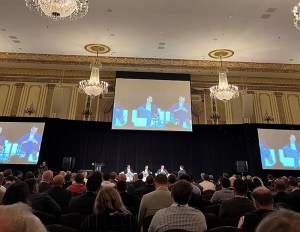What’s Ahead for Industrial? SIOR Conference Report
Expert insights from the organization’s fall event in Chicago.
One of the darling assets of commercial real estate, industrial’s fundamentals are continuing forward with strength. “It’s not at the torrent pace that we previously saw, but industrial is still really healthy”, Brian Erlanson, Link Logistics market officer, said during the industrial panel held at the SIOR Fall 2023 Event in Chicago.
He added that many markets are experiencing local organic growth coupled with a broad range of industrial users and an overall positive broker sentiment.
Patricia Loveall, executive vice president at CBRE and SIOR immediate past president, told Commercial Property Executive that she anticipates industrial to be very strong in 2024. “Demand is increasing; e-commerce is going to have an even bigger play. After taking a break in 2023, they are back with a vengeance; rents will rise; new developments will start,” she said.
READ ALSO: Manufacturing Rebound Faces Real Estate Roadblocks
While certain regions are still experiencing a growth in demand, others are set to slow down a bit due to factors such as a weaker labor force, tightening development regulations and negative migratory patterns. Further, a period of general economic uncertainty has led brokers adjusting to a new environment. On a national scale, industrial is overall expected to continue to perform well into next year, the panel led by Loveall agreed.
“We have all gotten used to a different level of activity, just a little readjustment,” Cameron Trefry, regional vice president, Ware Malcomb, said during the panel. “But we are still going strong and we will have a good year next year.”
The future of industrial buildings
Industrial spaces, including renovated existing inventory and new facilities, are changing. The future of industrial is beginning to take a new shape, particularly, a larger one.
“Buildings will continue to get taller and people are going to evaluate on a cube footage, rather than a square footage, basis,” Lovell told CPE.
The future of industrial means that tenants are going to be placing more value on how much product they can fit within a space. On the outside of a building, space is becoming critically important as well, Loveall noted, as more per yard space means more car parking, van parking, truck parking and industrial amenity space.
Along with taller clear-heights and bigger sites, industrial amenities are more important than ever. “People want to have a space where they can go outside and breathe fresh air,” Loveall said. “They want to have some nature in their work life.”
With a strong need for the retention and satisfaction of industrial workers, the future of industrial spaces needs to cater to the employees. Therefore, factors like workout facilities, air conditioning, private areas and green spaces are growing in popularity.
Industrial panelists similarly discussed the importance of having industrial amenities when it comes to retaining workforce numbers. “Labor is a huge factor,” said Sean Colletta, market officer at Prologis. “It gets asked about in every showing. The competition for labor doesn’t seem to have gone down at all.”
Along with amenities attracting and retaining a strong industrial workforce, another top priority is location. Where there is connectivity to outside amenities provided by a location, there is heightened attraction from the workforce. People want access to walking paths, restaurants, dining, entertainment and public transportation.
Moving forward
As industrial braves increased interest rates, higher costs of capital, expensive construction fees and a bid-ask spread, the deals that pencil moving forward are going to have to be strategic. Yet, when compared to the activity of other asset classes, industrial remains a bright spot.
“We are all optimistic and glad we are in industrial real estate right now,” said Colletta.
During 2024, predictions at SIOR weighed in to say that there may be some decreases in demand. Moreover, deals that are moving forward are as calculated as ever. That means weighing in every factor, including location, amenities, labor workforce, local regulations and more.
“The message [from the industrial panel] was clear,” said Loveall. “They are still open for business. They are still doing deals, but they scrutinize their deals even perhaps greater than they did in the past. There is access to money, but the economics of a deal must make sense and they are going to take less risk than they were willing to before.”








You must be logged in to post a comment.